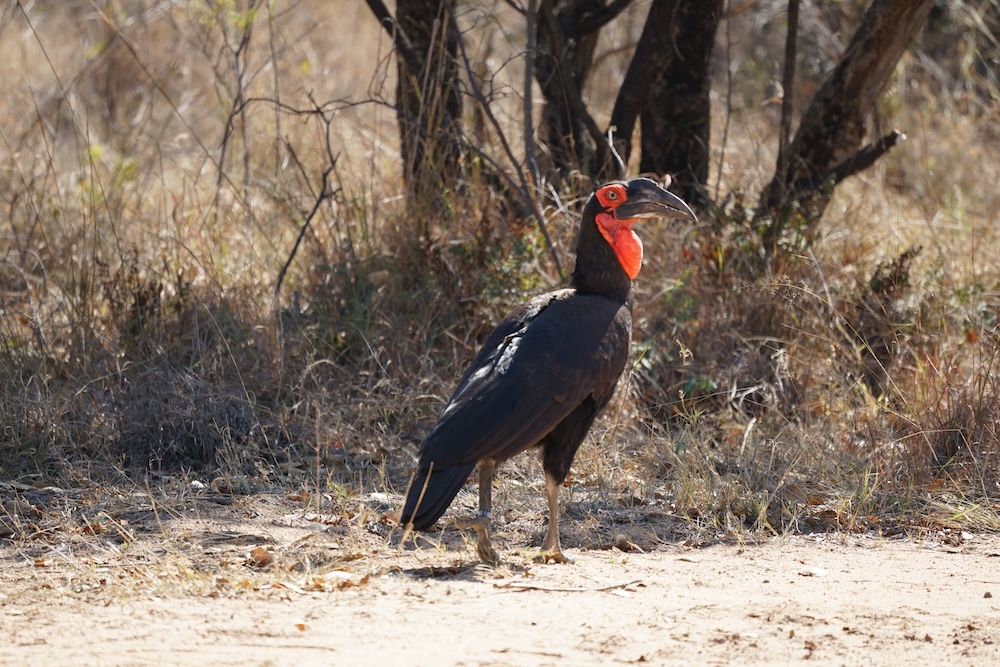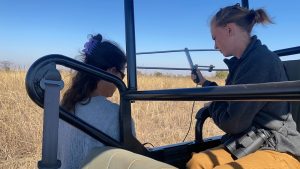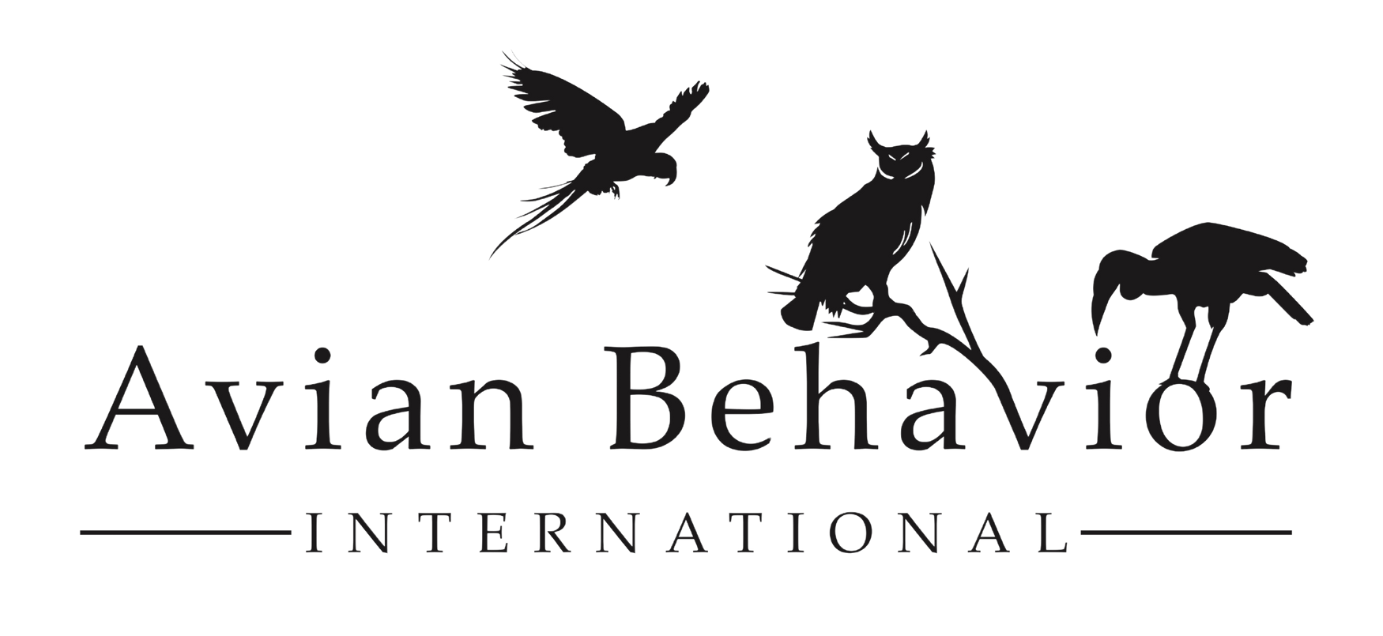
29 Dec Whatever it Takes: Collaboration to Save a Species
In this day and age, finding examples of cross-disciplinary collaboration to reach a mutual goal is not as easy as you would think. As much as we love to share our passions, a quick scan of social media comments will reveal that often we are divided even in the pursuit of how we need to achieve a common goal. Fortunately, there are some cases where leaders of their field have shown that this is not going to be the case in something that truly matters on a global scale. Such is the case with a team that is working to save the Southern ground hornbill from extinction.
In August 2023, Avian Behavior International founder Hillary Hankey and Animal Care Manager Katie Pnewski spent two weeks at the Baobab Rearing Center at Loskop Natural Reserve and at release sites in the Southern Ground Hornbill historical range at Mabula Game Reserve and surrounding area observing three released family groups with Mabula Ground Hornbill Project. The purpose of our visit was at the request of Mabula Project Manager and esteemed conservationist, Dr. Lucy Kemp, to assess current conditions and challenges and make suggestions for implementation of the 2023-24 rearing season to increase the chance of success of released individuals by lowering the risk of imprinting and habituation to humans. This was an incredibly special opportunity for cross-disciplinary collaboration among in-situ field biologists and ex-situ behavior specialists.
Lucy Kemp, to assess current conditions and challenges and make suggestions for implementation of the 2023-24 rearing season to increase the chance of success of released individuals by lowering the risk of imprinting and habituation to humans. This was an incredibly special opportunity for cross-disciplinary collaboration among in-situ field biologists and ex-situ behavior specialists.
We produced a follow-up report that addressed these looming challenges and helped provide structure to the changes that will need to be implemented. As with any project working with behavior, we were keenly aware that what exists on paper is likely to change as we apply the science to living beings in a dynamic environment. The report is designed to be a living document as we put the objectives in to action as well as collaborate with other organizations that have undertaken complex reintroduction efforts.
Southern ground hornbills lay two eggs and only raise one chick. The second egg is the insurance egg in case the first doesn’t hatch. The biologists from the Mabula Ground Hornbill Project collect the chick from the second egg as soon as it hatches to raise and release the bird in a social group in efforts to increase the numbers of hornbills in the wild.
The reintroduction program of the southern ground hornbill is unique for a few specific reasons related to this bird’s’ significant life history characteristics:
- They are incredibly territorial with expansive home territories and low rates of what is known as dispersal. Dispersal is when fledged offspring move into neighboring territories for gene flow. The goal of the Project is to link fragmented populations and encourage natural gene flow (Kemp and Bruford, 2018).
- Southern ground hornbills have complex social and learning structure with a slow life history necessitates reintroduced groups follow a well researched formula that supports a trio including two males: a naïve individual, a bush school master, and the appropriately aged female (Kemp et al, 2020). They must learn to hunt cooperatively for prey including highly venemous snakes in the African bush.
- Territorial characteristics and foraging habits both inevitably bring them in close contact to human populations, which increases the risk of lead toxicosis, nuisance behavior, and problematic food conditioning and habituation. Remember, fed wildlife is dead wildlife, no matter what continent you are on.
Our first objective was to look at effective co-parenting strategies for this species at the Baobab Rearing Center at Loskop Nature Preserve. Coparenting is the practice of joint rearing of nestling birds between human and conspecific adult birds. How the duties are divided depends on the desired goals and the capabilities and temperament of the parents or foster parents. The Baobab Center was designed for this practice to have non-releaseable pairs mentor the co-parented chicks.
The second objective we identified was building the ideal release group. While Dr. Kemp and other biologists have done much research on what makes a successful release group, there are times when a chick might imprint or habituate on humans as it spends time in human care. We identified practices and procedures here to test our theories on how to maximize the potential of less than ideal candidates given this intelligent and highly social species.
Our third objective was to re-orchestrate supplemental feeding strategies in the bush for the winter months. Supplemental feeding is necessary in the early years of reintroduction to keep the birds from coming in to contact with human development, where they are more likely to get shot, captured, or poisoned. This is a challenging endeavor.
Our fourth objective was aversion training to keep the hornbills from anthropogenic (human-caused) lethal conditions. These are areas such as those with uninsulated transformers and landfills. Aversion training has been used with condors, cranes and other species to condition them to avoid human-caused dangers.
 And our fifth objective was to come up with protocols for re-trapping released adults for health assessments and transmitter adjustments. As smart birds, the Project is only able to trap them once, and then it is exceedingly difficult to re-trap them.
And our fifth objective was to come up with protocols for re-trapping released adults for health assessments and transmitter adjustments. As smart birds, the Project is only able to trap them once, and then it is exceedingly difficult to re-trap them.
All in all, we had five very ambitious objectives that involve collaboration with other organizations and feedback from the field team. We are thrilled to aid assistance to a high-functioning, capable team that is doing incredible work. And a huge thank you to our Go Fund Me supporters, without which this project would not have been possible.
You can listen to our interview on the latest episode of the Avian Behavior Podcast.
As always, a huge thank you for your support of our work. Every program, every Lab member, every Experience means that our reach can broaden, we sharpen our skills, we learn more about how to connect humans and the challenges birds face so that we can continue to live in a world populated with birds.

